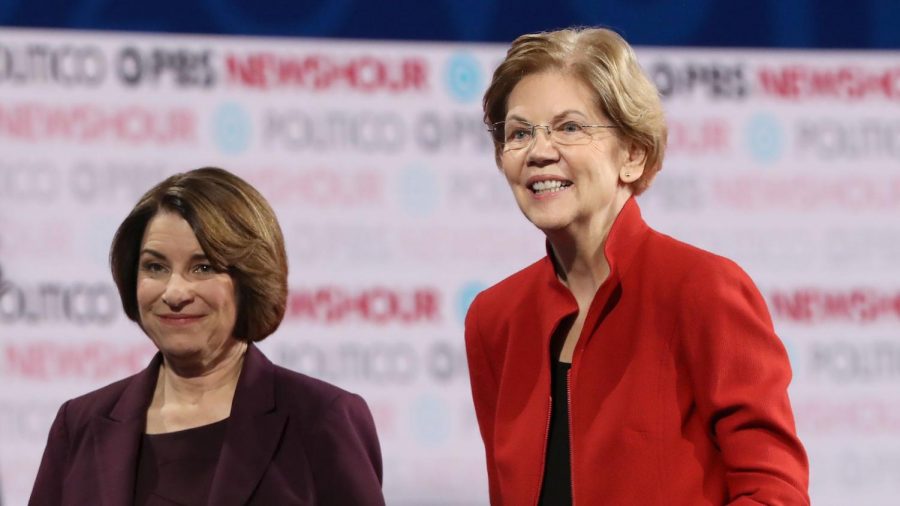Politics you should care about
The New York Times endorsed Senators Elizabeth Warren and Amy Klobuchar for the Democratic nomination. Many were confused by the endorsement.
January 23, 2020
What a time it is to be American.
For only the third time in United States history the president has been impeached. Now, we’re caught in the midst of an impeachment trial like no other, with heated procedural arguments dominating National Public Radio’s (NPR) soundbites. Debates over precedent have persisted up until the trial itself, and the speculation over who may break from the Republican position continues to build.
But believe it or not, this edition of “Politics you should care about” is not going to talk about impeachment, mainly because there’s little more that can be said about it. For this roundup, we’re going to look at what was previously the U.S.’s most-discussed political topic, the Democratic primary, as well as an economic issue that at first glance doesn’t appear to affect students.
The New York Times’ double endorsement
Over the past month, The New York Times has been interviewing the candidates vying for the Democratic nomination. In theory, these conversations would provide insight not just for the readers, but also for the paper as it prepared to release its endorsement.
After ending this series, The Times made a move that left many genuinely speechless: it endorsed both Elizabeth Warren and Amy Klobuchar. Now, a paper’s endorsement is typically not big news, unless it has acted against expectations of their partisanship. What makes this instance noteworthy, however, is what it highlights about coverage of this primary.
For one, it simply reflects a concession to the innate divisiveness that large news organizations helped churn up. Since the beginning of the primary, and especially when the debates kicked off, media outlets have been quick to highlight any spats or potential points of dispute between candidates. Articles rapidly blew through social media claiming that candidates had directly attacked one another, while old-guard politicians or staffers would be dragged in for their takes on a candidate’s statements.
Forgive the metaphor, but it began to resemble one of those Real Housewives reunions hosted by Andy Cohen. Everyone’s words and actions of the past few months were brought back up, with the “moderators” (in this case TV or Twitter pundits) sitting back and enjoying the show they had created.
Take the Sanders versus Warren battle that occurred last week. What started as a scuffle over a memo sent out by a Sanders Campaign staffer quickly escalated into an argument over whether Sanders had said a woman couldn’t beat Donald Trump. It culminated in a pair of tense exchanges between the two progressive candidates, where each claimed to have been called a liar by the other. But the memo’s legitimacy has been called into question by those within the Sanders campaign, and many within the party feel that this issue was stirred up simply to create more in-fighting.
The double-endorsement could only exacerbate this issue, as it seems to again reinforce an idea that the Democratic party is too split for any kind of consensus. Sure, now people know which moderate and progressive The Times supports, but this is exactly the problem. It no longer feels like a competition between candidates on the same team, rather a debate over which Democratic faction is superior.
It’s a pattern to pay attention to down the stretch, as candidates are running low on time to focus on one another. If enough turmoil is generated within the party, it becomes that much more difficult to focus on your opponent across the aisle.
A truce in a trade war
In a relatively measured move, the U.S. and China agreed to the early stages of a trade agreement. This comes a few weeks after a revised version of the United States-Mexico-Canada Agreement (USMCA), which takes the place of the North American Free Trade Agreement (NAFTA), easily passed through Congress. So compared with the posturing of the past few years, the U.S. has set itself up to be quite open economically.
But this isn’t the end of our fight with China, nor is it a sign that we’ve necessarily done any good through that dispute. This “phase one” agreement does little good beyond putting some tensions to bed, and economists have questioned if this benefit was even worthwhile.
Some have questioned whether it is possible for China to follow through on its agreement to purchase American goods. In an interview with CNBC, Jeff Currie, a Goldman-Sachs commodities expert, doubted that $50B in agricultural purchases was even possible with current market arrangements.
Writing for the Financial Times, Martin Wolf scorned the deal as “defective.” Of his many critiques, the most notable is directed at the intellectual property measures included in the deal, considered by many to be the centerpiece. However, these new restrictions on the theft of intellectual property may ultimately be nullified by the effects of the trade war. With reduced dependency on the U.S., China has and will likely continue to become more self-sufficient, especially in technology.
For U.S. students, this could end up affecting the industries they intend to enter upon graduation. A hallmark example, which returned to the spotlight after the deal was signed, is the semiconductor industry. After tariffs were put in place, there was seemingly less and less incentive for China to rely on the U.S. as an exporter, weakening a dominant U.S. export. Even with the restrictions lifted, the effects of the move will at least partially remain, and experts are only hoping they won’t compound in the aftermath. Continued losses in the Chinese market could put a lid on an explosive job market in technology, all the while weakening the U.S.’s overall trade position.
It’s yet another confusing step forward for the U.S.’s trade economy, and it perhaps solidifies how the administration’s baffling attempts at protectionism have tended to generate the opposite of their intended effects.



